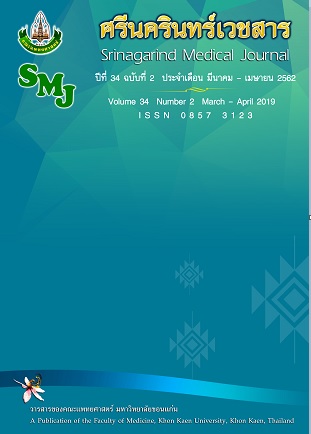The Optimal Cut-off Score of the 2-Minute Step Test for Prediction of Cardiopulmonary Endurance in Older Adults with Hypertension
Keywords:
Elderly; hypertension, cardiopulmonary endurance; 6 minute walk test; 2 minute step testAbstract
Background and Objective: 2MST is an alternative test for assessment of cardiopulmonary endurance in the older when 6MWT unable to perform due to space limitations or weather prohibits. However, the study of using 2MST for assessing the cardiopulmonary endurance in hypertensive Thai elderly has not been investigated. Therefore, the aimed of the present study was to evaluated functional ability of 2MST for predict of cardiopulmonary endurance in hypertensive elderly.
Method: The ninety-seven hypertensive elderly volunteers who were over 60 years old. Cardiopulmonary endurance was determined by using 6MWT which divided into 2 groups; low and normal cardiopulmonary endurance group. By following, all subjects were taken rest for 60 minutes before starting the 2MST. The sensitivity, specificity, area under the curve, and cut off point, were assessed for significant using receive-operating characteristic (ROC) curve.
Results: The results showed that the normal cardiopulmonary endurance group had number of leg rises in 2 minutes higher than the low cardiopulmonary endurance group (69.89±12.16 and 53.14±12.58 repetitions, respectively; p<0.001). 2MST was moderately correlated with 6MWT (r= 0.721; p <0.001). Moreover, the cutoff point of number of leg rises was 60 repetitions in 2 minutes (sensitivity 81.13%, specificity 63.64%, and area under the curve 0.83; 95% CI = 0.75-0.91).
Conclusion: Older adults with hypertension who had less number of leg rises than 60 repetitions in 2 minutes were indicated to risk or low cardiopulmonary endurance.
References
2. Rizzuto D, Melis RJ, Angleman S, Qiu C, Marengoni A. Effect of chronic diseases and multimorbidity on survival and functioning in elderly adults. J Am Geriatr Soc 2017;65:1056-60.
3. Mitchell GF. Arterial stiffness and hypertension. Hypertension 2014;64:13-8.
4. Lionakis N, Mendrinos D, Sanidas E, Favatas G, Georgopoulou M. Hypertension in the elderly. World J Cardiol 2012; 4: 135-47.
5. Pedrosa R, Holanda G. Correlation between the walk, 2-minute step and TUG tests among hypertensive older women. Braz J Phys Ther 2009;13: 252-6.
6. American College of Sports Medicine. ACSM's guidelines for exercise testing and prescription. Philadelphia: Wolters Kluwer; 2018.
7. van Iersel MB, Munneke M, Esselink RA, Benraad CE, Rikkert MGO. Gait velocity and the Timed-Up-and-Go test were sensitive to changes in mobility in frail elderly patients. J Clin Epidemiol 2008; 61: 186-91.
8. Casillas JM, Hannequin A, Besson D, Benaïm S, Krawcow C, Laurent Y, et al. Walking tests during the exercise training: Specific use for the cardiac rehabilitation. Ann Phys Rehabil Med 2013; 56: 561-75.
9. Simonsick EM, Montgomery PS, Newman AB, Bauer DC, Harris T. Measuring fitness in healthy older adults: the Health ABC Long Distance Corridor Walk. J Am Geriatr Soc 2001; 49: 1544-8.
10. Jones CJ, Rikli RE. Measuring functional fitness of older adults. The Journal on Active Aging 2002; 1: 24-30.
11. Miotto JM, Chodzko-Zajko WJ, Reich JL, Supler MM. Reliability and validity of the fullerton functional fitness test: an independent replication study. J Aging Phys Act 1999; 7: 339-53.
12. Guedes MBOG, Lopes JM, Andrade AdS, Guedes TSR, Ribeiro JM, Cortez LCdA. Validation of the two minute step test for diagnosis of the functional capacity of hypertensive elderly persons. Rev. Bras Geriatr Gerontol Rio de Janeiro 2015; 18: 921-6.
13. กองวิทยาศาสตร์การกีฬา ฝ่ายวิทยาศาสตร์การกีฬา การกีฬาแห่งประเทศไทย. แบบทดสอบสมรรถภาพทางกายอย่างง่ายของการกีฬาแห่งประเทศไทย พ.ศ. 2546. [ค้นเมื่อ 25 กันยายน 2561]. Available from: https://kupdf.net/download/-_596e2caddc0d60491da88e78_pdf#.
14. ATS statement: guidelines for the six-minute walk test. Am J Respir Crit Care Med 2002; 166: 111-7.
15. Kamontip Harnphadungkit. 6-Minute Walk Test. J Thai Rehabil Med 2014; 24: 1-4.
16. Albouaini K, Egred M, Alahmar A, Wright DJ. Cardiopulmonary exercise testing and its application. Postgrad Med J 2007; 83: 675-82.
17. Rikli RE, Jones CJ. Development and validation of a functional fitness test for community-residing older adults. J Aging Phys Act 1999; 7: 129-61.
18. Alosco ML, Spitznagel MB, Raz N, Cohen R, Sweet LH, Colbert LH, et al. The 2-minute step test is independently associated with cognitive function in older adults with heart failure. Aging Clin Exp Res. 2012; 24: 468-74.
19. Wegrzynowska-Teodorczyk K, Mozdzanowska D, Josiak K, Siennicka A, Nowakowska K, Banasiak W, et al. Could the two-minute step test be an alternative to the six-minute walk test for patients with systolic heart failure? Eur J Prev Cardiol 2016; 23: 1307-13.
20. Pandey A, Park BD, Ayers C, Das SR, Lakoski S, Matulevicius S, et al. Determinants of racial/ethnic differences in cardiorespiratory fitness (from the Dallas Heart Study). Am J Cardiol 2016; 118: 499-503.
21. Poh H, Eastwood PR, Cecins NM, Ho KT, Jenkins SC. Six-minute walk distance in healthy Singaporean adults cannot be predicted using reference equations derived from Caucasian populations. Respirology 2006; 11: 211-6.
22. McPhee JS, French DP, Jackson D, Nazroo J, Pendleton N, Degens H. Physical activity in older age: perspectives for healthy ageing and frailty. Biogerontology 2016; 17: 567-80.
23. Silva NA, Menezes TNd. Functional capacity and its association with age and sex in an elderly population. Braz J Kinathrop Hum Perform. 2014; 16: 359-70.
24. Jakovljevic DG. Physical activity and cardiovascular aging: Physiological and molecular insights. Exp Gerontol 2017; 109: 67-74.
25. Maranhão Neto GA, de Leon AP, Lira VA, Farinatti PTV. Assessment of cardiorespiratory fitness without exercise in elderly men with chronic cardiovascular and metabolic diseases. J Aging Res 2012; 2012: 518045.
26. Blair SN, Sallis RE, Hutber A, Archer E. Exercise therapy - the public health message. Scand J Med Sci Sports 2012; 22: 24-8.
27. Knight JA. Physical inactivity: associated diseases and disorders. Ann Clin Lab Sci 2012; 42: 320-37.
28. Milanovic Z, Pantelic S, Trajkovic N, Sporis G, Kostic R, James N. Age-related decrease in physical activity and functional fitness among elderly men and women. Clin Interv Aging 2013; 8: 549-56.
29. Purkiss S, Huckell VF. Cardiovascular physiology: similarities and differences between healthy women and men. J Obstet Gynaecol Can 1997;19: 853-9.



